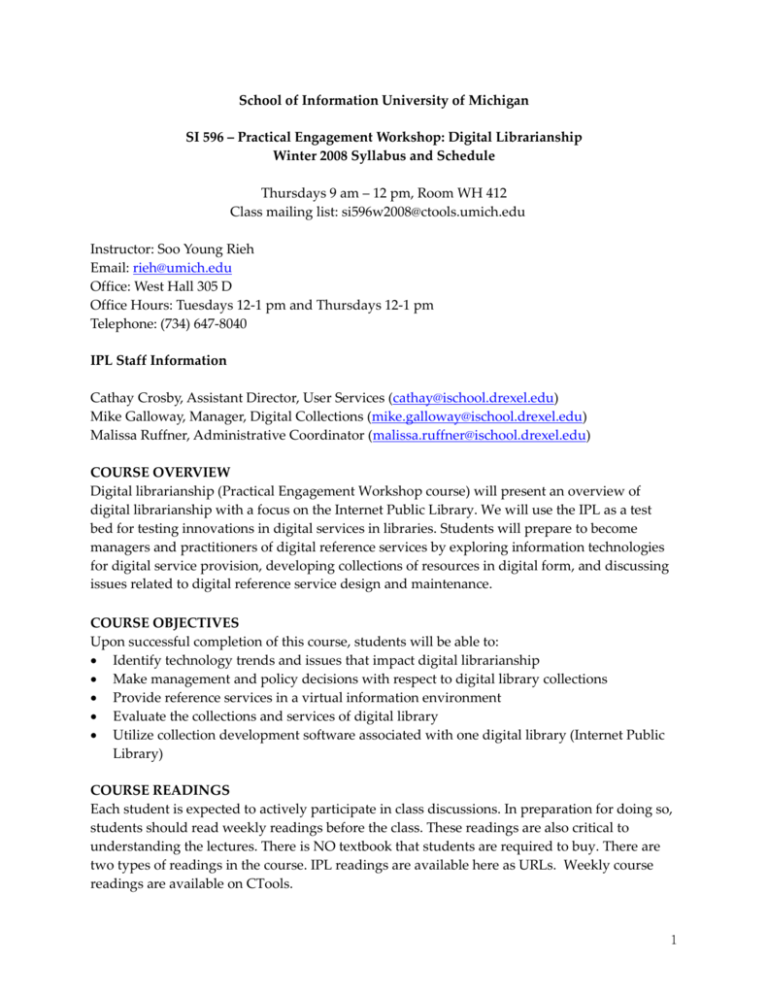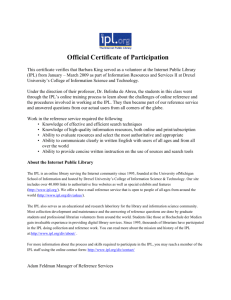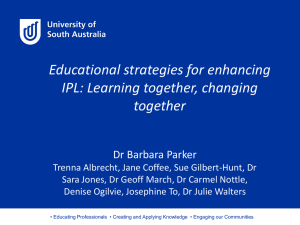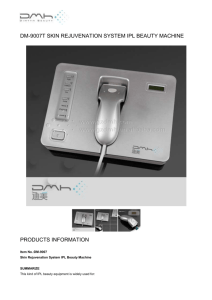School of Information University of Michigan
advertisement

School of Information University of Michigan SI 596 – Practical Engagement Workshop: Digital Librarianship Winter 2008 Syllabus and Schedule Thursdays 9 am – 12 pm, Room WH 412 Class mailing list: si596w2008@ctools.umich.edu Instructor: Soo Young Rieh Email: rieh@umich.edu Office: West Hall 305 D Office Hours: Tuesdays 12-1 pm and Thursdays 12-1 pm Telephone: (734) 647-8040 IPL Staff Information Cathay Crosby, Assistant Director, User Services (cathay@ischool.drexel.edu) Mike Galloway, Manager, Digital Collections (mike.galloway@ischool.drexel.edu) Malissa Ruffner, Administrative Coordinator (malissa.ruffner@ischool.drexel.edu) COURSE OVERVIEW Digital librarianship (Practical Engagement Workshop course) will present an overview of digital librarianship with a focus on the Internet Public Library. We will use the IPL as a test bed for testing innovations in digital services in libraries. Students will prepare to become managers and practitioners of digital reference services by exploring information technologies for digital service provision, developing collections of resources in digital form, and discussing issues related to digital reference service design and maintenance. COURSE OBJECTIVES Upon successful completion of this course, students will be able to: Identify technology trends and issues that impact digital librarianship Make management and policy decisions with respect to digital library collections Provide reference services in a virtual information environment Evaluate the collections and services of digital library Utilize collection development software associated with one digital library (Internet Public Library) COURSE READINGS Each student is expected to actively participate in class discussions. In preparation for doing so, students should read weekly readings before the class. These readings are also critical to understanding the lectures. There is NO textbook that students are required to buy. There are two types of readings in the course. IPL readings are available here as URLs. Weekly course readings are available on CTools. 1 IPL General Readings: Ask a Question Digital Reference Service: Student and Volunteer Training Manual. Available online at: http://www2.ipl.org:2000/backroom/refvols/students/ Or in PDF at: http://www2.ipl.org:2000/backroom/refvols/students/IPLTrainingManual.pdf IPL Collection Development Training Manual. Available online at: http://www.ipl.org:2000/backroom/col/ Weekly Readings and Lecture Slides on CTools Weekly lecture slides, course readings, additional resources for class assignments, and other useful materials will be maintained on CTools: http://ctools.umich.edu Course Requirements and Evaluation Readings and class participation: 10% A1. Environmental scan assignment: 15% A2. Competitor analysis assignment: 15% A3. IPL Staff Work and two reports: 30% A4. Grant proposal presentation and report: 30% SCHEDULE Week 1 (January 3): Course Overview; Digital Librarianship and IPL Choi, Y. & Rasmussen, E. (2006). What is needed to educate future digital librarians. D-Lib Magazine, 12(9). http://www.dlib.org/dlib/september06/choi/09choi.html Lynch, C. (2003). Colliding with the real world: Heresies and unexplored questions about audience, economics, and control of digital libraries. In A. P. Bishop, N. A. Van House, & B. P. Buttenfield (Eds), Digital library use: Social practice in design and evaluation (pp. 191-216). Cambridge, MA: MIT Press. Week 2 (January 10): Introduction to IPL; Environmental Scanning Janes, J. (1998). The Internet Public Library: an intellectual history. Library Hi Tech, 16 (2), 55-68. Abels, E. G. (February/March 2002). Environmental Scanning. Bulletin for the American Society for Information Science and Technology. 28(3) http://www.asis.org/Bulletin/Mar-02/abels.html De Rosa, C., Dempsey, L., & Wilson, A. (2004). 2003 Environmental Scan: Pattern Recognition. 2 OCLC Online Computer Library Center. http://www.oclc.org/reports/escan/toc.htm Week 3 (January 17): Collection Development in IPL Kovacs, D. K. & Elkordy, A. (2000). Collection development in cyberspace: building an electronic library collection. Library Hi Tech, 18(4), 335-359. Salinas, R. (2003). Addressing the digital divide through collection development. Collection Building, 22(3), 131-136. Lee, S. D. (2002). Electronic collection development: a practical guide. New York: Neal-Schuman Publishers. Chapters 4 & 5 (pp. 62-125). Week 4 (January 24): Hypatia 2.0 (IPL collection management tool) Guest Speaker: Mike Galloway (Drexel University) IPL Collection Development Training Manual. Available online at: http://www.ipl.org:2000/backroom/col/ Week 5 (January 31): Introduction to Digital Reference Janes, J. (2003), Introduction to Reference Work in the Digital Age. New York: Neal-Schuman Publishers, Inc. Chapter 2. Lankes, et al. (2001). Implementing digital reference services. New York: Neal-Schuman Publishers, Inc. Chapter 16 (pp. 171-183). Carter, D, and J. Janes. (2000). Unobtrusive data analysis of digital reference questions and service at the Internet Public Library: an exploratory study. Library Trends, 49(2):251- 265. Week 6 (February 7): QRC (IPL question-handling system) Guest Speaker: Cathay Crosby (Drexel University) MARS Digital Reference Guidelines Ad Hoc Committee. Guidelines for Implementing and Maintaining Virtual Reference Services. (2004). ALA RUSA. [Available online at http://www.ala.org/ala/rusa/rusaprotools/referenceguide/virtrefguidelines.htm Ask a Question Digital Reference Service: Student and Volunteer Training Manual. http://www2.ipl.org:2000/backroom/refvols/students/ Week 7 (February 14): Users’ information need and seeking; Understanding IPL users Horrigan, J. B. (2007). A typology of information and communication technology users. Pew Internet & 3 American Life report. http://www.pewinternet.org/pdfs/PIP_ICT_Typology.pdf Case, D. O. (2007). Looking for information: a survey of research on information seeking, needs, and behavior. 2nd edition. New York: Academic Press. Chapter 4: Information needs and information seeking. Week 8 (February 21): Evaluation of digital reference services Nilsen, K. & Ross, C. S. (2006). Evaluating virtual reference from the users’ perspective. The Reference Librarian, No. 95/96, 53-79. Pomerantz, J., Nicholson, S. Belanger, Y. & Lankes, R. D. (2004). The current state of digital reference: Validation of a general digital reference model through a survey of digital reference services. Information Processing and Management, 40, 347-363. White, M.D. (2001). Digital reference services: framework for analysis and evaluation. Library & Information Science Research, 23(3), 211-231 Week 9 (February 28) NO CLASS – SPRING BREAK Week 10 (March 6): Guest Speaker: Susan Hollar (University of Michigan Library) Week 11 (March 13): Digital library use Borgman, C. L. (2000). Ch 5. Why are digital libraries hard to use In From Gutenberg to the global information infrastructure (pp. 117-141). Cambridge, MA: MIT Press Marchionini, G., Plaisant, C., Komlodi, A. (2003). The people in digital libraries: Multifaceted approaches to assessing needs and impact (pp. 119-160). In A. P. Bishop, N.A. Van House, B. P. Buttenfield (Eds.), Digital library use: Social practice in design and evaluation. Cambridge, MA: MIT Press. Week 12 (March 20): Evaluation of digital library Saracevic, T. (2000). Digital library evaluation: Toward an evolution of concepts. Library Trends, 49(2), Fall 2000, 350-369. Fuhr, N., Hansen, P., Mabe, M., Micsik, A., & Sølvberg, I. (2001). Digital libraries: A generic classification and evaluation scheme. Lecture Notes in Computer Science, 2163, 187-199: http://citeseer.ist.psu.edu/cache/papers/cs/24000/http:zSzzSzwww.sics.sezSz~prebenzSzpapersz Szecdl-2001.pdf/fuhr01digital.pdf 4 Week 13 (March 27): Future Directions of IPL: Collection, Service, and Technology Madden, M. & Fox, S. (2006). Riding the waves of “Web 2.0”. Pew Internet & American Life report. http://www.pewinternet.org/pdfs/PIP_Web_2.0.pdf Anderson, J. Q. & Rainie, L. (2006). The future of the Internet II. Pew Internet & American Life Report. http://www.pewinternet.org/pdfs/PIP_Future_of_Internet_2006.pdf Week 14 (April 3); Presentations of Proposal Week 15 (April 10): More Presentations; Issues and Wrap-Up 5 Assignments A1. Environmental scan assignment: 15% Plan is due January 17 Handout and Log are due March 13 Students will develop an environmental scan plan and perform an environmental scan to identify information technologies that might be incorporated into a digital library such as the IPL. Develop a scanning plan: Students will develop a list of publications and websites to include in their scans. Scanning activities should include a variety of daily newspapers (Washington Post, Los Angeles Times, New York Times, WSJ, etc.) as well as weekly and monthly magazines (Business Week, PC Magazine, PC Week, Info Today, Online, Forbes, Fortune, etc.). Students may read either the electronic or print version of these publications. Radio broadcasts (e.g., NPR) and television news (e.g., CNBC) can also be included in the scan. Remember that to come up with new and interesting ideas, it is necessary to read broadly and to read between the lines; look for unusual technological applications in other settings. Monitoring related listservs may also be useful in identifying digital reference technologies. The scanning plan should include a citation for the publication/broadcast/website, the frequency with which this item will be scanned, and the reason for including. Scanning log: Students are to maintain a log of readings and exploration. Each entry in the log will contain a brief citation of an article or newscast (or the name of a digital library and URL including date accessed or date scanned) and a brief annotation that discusses the technology identified. Deliverables: Scanning plan which includes the list of publications and resources with complete citations and frequency with which scan is recommended. The plan should note why the item was included. Note that you may include some items in your plan which ultimately are not useful and do not yield any technology ideas – you may discontinue scanning this item and note that on the final plan submitted. List should include a variety of items, including publications or different types and different media. 30 points. Handout for classmates that highlights technologies identified during the week (we will have about 5 short presentations per week). 40 points. Log of specific readings with annotations. 30 points. 6 A2. Competitor analysis assignment: 15% Report is due February 7 Students will complete competitor analysis on another service out there which is similar to or relevant to the IPL. Examples include: Librarians’ Internet Index, Yahoo! Answers, The Educator’s Reference Desk, etc. Students will submit a 5-page-long report (single-spaced). The report will contain the following sections: (1) a short description of the IPL; (2) on what aspects you can define a competitor(s) (in terms of audience, service, values, etc.); (3) detailed comparative analysis of the competitor’s service or product. The analysis will include: what this service does; the clientele; the service providers; how this service is financially supported; and other relevant policies and issues. 7 A3. IPL Staff Work: 30% (each paper 15%) Report 1 is due February 21 Report 2 is due March 27 All student staff members will work as an IPL staff member either as a Reference Administrator (RefAdmin) or a Collection Developer (ColDev). Students need to inform their role to the instructor by February 7. If you are interested in working as a RefAdmin, you must take steps in the training process by completing one practice question. If you took SI 647 and already took these steps in Practice Question, you can be opted out from it and move on to real questions in QRC. The RefAdmin’s job will be composed of two tasks: Answering 5-10 user questions through Ask A Question and reviewing at least five user suggestions for addition to the IPL, and forward their decision to ColDev. ColDev’s work activities will include link checking; source evaluations; keyword exploration; and FARQ and Pathfinder updating. ColDevs are encouraged to include a wide range of activities in their weekly work to best understand the breadth of collection development activities. If you decided to work as a ColDev, pleas submit your Gmail address through this form http://www.ipl.org:2000/div/backroom/col/gmailsubmissionform.html Deliverables Students will submit two activity reports. Report 1 will be shorter (2-3 pages) while Report 2 will be about 3-5 pages. Each report will contain the following sections: a) accomplishments to date (or since last report); b) problems encountered; and c) suggestions and thoughts about the IPL. Grading Rubric for reports include: - Covers accomplishments, problems encountered, suggestions and thoughts - Activities described represent required IPL contribution - Discussion reflects understanding of IPL mission, goals, and operations - Overall presentation, e.g. neatly presented, well organized, well written 8 A4. Innovation Proposal presentation and report: 30% Report is due April 10 Presentation will be scheduled either April 3 or April 10 Students, as an individual or as a group (no more than three), will write up a proposal and present it in the class. Students need to come up with innovative ideas that can advance the IPL for the next one or two years. A proposal can present new ideas of creating significant digital resources as well as development of tools and features while incorporating new technologies. A proposal should show how your project can ensure that the new ideas can promote access to the IPL resources and services. Proposed projects may: develop and disseminate new tools that facilitate management, preservation, sharing, and use of digital resources; increase community access to digital resources through innovative use of existing technology-based tools; increase community access to institutional resources by improving practice in use, dissemination, and support of existing technology-based tools; digitize, preserve, and aggregate digital content in IPL develop new approaches or tools for IPL Deliverables Abstract (1 page): A project abstract not exceeding one single-spaced page (600-word maximum) must be provided. Information in the abstract should cover the following areas as related to the proposed project: What is the time frame for the project? What community need(s) will the project address? Who is the intended audience for the activities? What will be the project’s activities, outcomes, and tangible products? Narrative (10 pages): Limit the narrative to ten single-sided, single-spaced, numbered pages. Your proposal should include the identification of a problem, assessment of potential solutions, development of a proposed approach, and presentation of creative solutions to significant problems. Ideas need not be entirely new, but can have innovative impact. The best proposals may improve on or extend previous practice in a significant way. Successful proposals will explain how results will benefit the professional community as well as the public. Budget (1-2 pages) Schedule of completion (1 page) 9






